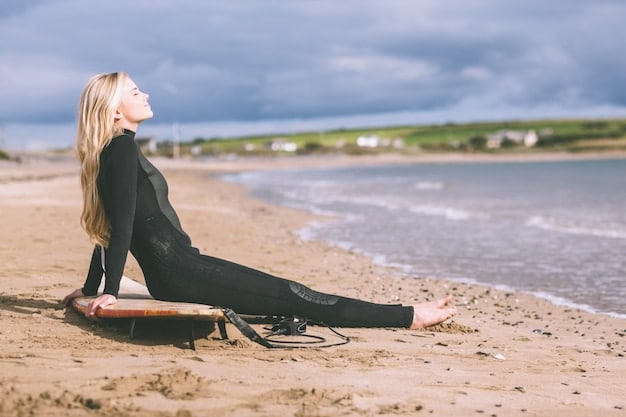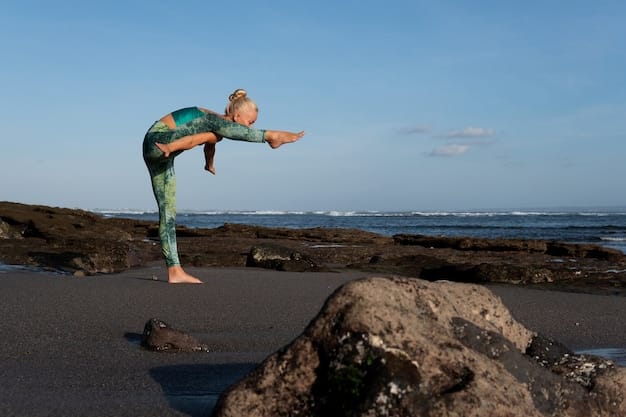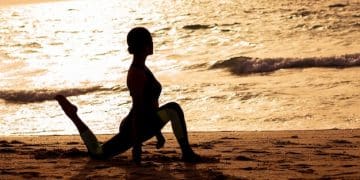Beach Yoga for Surfers: Enhance Performance with Flexibility & Balance

Beach yoga for surfers is a specialized practice that combines traditional yoga poses with exercises tailored to improve surfers’ flexibility, balance, and core strength, ultimately enhancing their performance on the waves.
Are you a surfer looking to elevate your skills and carve through the waves with more finesse? Integrating beach yoga for surfers: improve flexibility and balance for enhanced performance into your routine can be a game-changer, helping you achieve better balance, increased flexibility, and enhanced core strength, all essential for peak surfing performance.
Why Beach Yoga is a Surfer’s Secret Weapon
Surfing demands a unique blend of physical and mental capabilities. While paddling strength and wave knowledge are crucial, flexibility and balance often determine how well you ride. Beach yoga addresses these critical areas, offering a holistic approach to improve your surfing prowess.
But what exactly makes yoga so beneficial for surfers? Let’s dive into the specifics.
Improved Flexibility
Flexibility allows you to perform more dynamic movements on your board, making it easier to adjust your stance and react to changing wave conditions.
- Increased Range of Motion: Yoga stretches target tight muscles, enhancing your overall range of motion.
- Injury Prevention: Flexible muscles are less prone to strains and tears, reducing the risk of surfing-related injuries.
- Enhanced Performance: Greater flexibility enables more fluid and powerful maneuvers on the wave.

Enhanced Balance
Balance is paramount for maintaining stability on a moving surfboard. Yoga poses that challenge your equilibrium enhance your ability to stay centered and react quickly.
- Core Engagement: Many yoga poses require constant core engagement, strengthening the muscles responsible for balance.
- Proprioception: Yoga improves your body’s awareness in space, enhancing your sense of balance.
- Reduced Wobbling: Consistent practice leads to a more stable and controlled stance on your board.
In summary, beach yoga provides surfers with a complementary practice that enhances both flexibility and balance, leading to improved performance on the waves and a reduced risk of injuries.
Essential Yoga Poses for Surfers
While many yoga poses are beneficial, some stand out as particularly effective for surfers. These poses target the key muscle groups used in surfing and promote the flexibility and balance needed to excel.
Here are some essential yoga poses that every surfer should incorporate into their routine.
Downward-Facing Dog (Adho Mukha Svanasana)
This pose stretches the hamstrings, calves, and spine, while also strengthening the arms and shoulders. It’s a great way to warm up the body and improve overall flexibility.
Warrior Poses (Virabhadrasana I, II, III)
Warrior poses build strength and stability in the legs and core, enhancing balance and focus. They also open the hips and chest, improving flexibility and breathing.
Pigeon Pose (Eka Pada Rajakapotasana)
Pigeon pose deeply stretches the hip flexors, glutes, and lower back, relieving tension and improving hip mobility. This is particularly beneficial for surfers who often experience tightness in these areas.
Tree Pose (Vrksasana)
Tree pose challenges balance and coordination, strengthening the ankles and legs. It also promotes mental focus and stability, essential for staying calm in challenging surf conditions.

Incorporating these essential yoga poses into your regular routine will significantly improve your surfing by enhancing flexibility, balance, and overall body awareness.
Crafting Your Beach Yoga Routine for Surfing
Creating a beach yoga routine tailored to surfing doesn’t have to be complicated. The key is to focus on poses that address the specific needs of surfers, such as flexibility in the hips and hamstrings, core strength, and balance.
Here’s how to design a beach yoga routine that complements your surfing sessions.
Warm-Up
Begin with a gentle warm-up to prepare your body for deeper stretches. This can include:
- Sun Salutations: A series of poses that flow together, warming up the entire body.
- Cat-Cow Pose: Improves spinal flexibility and core engagement.
- Gentle Twists: Releases tension in the spine and improves mobility.
Main Sequence
Focus on poses that target flexibility, balance, and core strength. Examples include:
- Downward-Facing Dog: Stretches hamstrings and calves.
- Warrior Poses: Builds strength and balance.
- Pigeon Pose: Opens hips and relieves tension.
- Tree Pose: Enhances balance and focus.
- Plank Pose: Strengthens core and upper body.
Cool-Down
End your routine with cooling poses to relax your muscles and promote recovery. Consider:
- Seated Forward Fold: Stretches hamstrings and lower back.
- Supine Twist: Releases tension in the spine.
- Savasana (Corpse Pose): Allows for deep relaxation and integration.
By following this structure, you can design a beach yoga routine that effectively prepares your body for surfing, reduces the risk of injuries, and enhances your overall performance.
The Mental Edge: Mindfulness and Focus in Beach Yoga
Beyond the physical benefits, beach yoga offers a mental edge that’s invaluable for surfers. The practice of mindfulness and focus can enhance your concentration, reduce anxiety, and improve your decision-making skills in the water.
Here’s how mindfulness and focus contribute to your surfing performance.
Increased Awareness
Mindfulness involves paying attention to the present moment without judgment. This heightened awareness extends to your senses, allowing you to better perceive the ocean’s conditions, your body’s movements, and your emotional state.
Reduced Anxiety
Surfing can be exhilarating, but it can also be stressful, especially in challenging conditions. Yoga’s focus on breath and body awareness can help calm your nervous system, reducing anxiety and promoting a sense of control.
Improved Decision-Making
Clear and focused thinking is essential for making quick decisions on the wave. Yoga’s practice of concentration enhances your ability to assess situations, anticipate changes, and respond effectively.
Enhanced Connection with Nature
Practicing yoga on the beach connects you more deeply with the natural environment, fostering a sense of gratitude and respect for the ocean. This connection can enhance your overall surfing experience, making it more enjoyable and fulfilling.
In incorporating mindfulness and focus into your beach yoga practice, you not only enhance your physical abilities but also cultivate a mental resilience that allows you to perform at your best in the surf.
Overcoming Challenges: Adapting Yoga to the Beach Environment
While practicing yoga on the beach offers unique benefits, it also presents certain challenges. The uneven surface, wind, and sun can all affect your practice. However, with a few adjustments, you can overcome these challenges and enjoy the full benefits of beach yoga.
Here’s how to adapt your yoga practice to the beach environment.
Finding a Stable Surface
Choose a relatively flat and stable area of the beach to practice on. Avoid areas with loose sand or significant slopes. If necessary, use a yoga mat to create a more stable surface.
Adjusting for Wind
Wind can make balancing poses more challenging. Lower your center of gravity and widen your stance to increase stability. You can also choose to face into the wind, which can help you stay grounded.
Protecting from the Sun
The sun can be intense on the beach, especially during midday. Practice in the early morning or late afternoon when the sun is less direct. Wear sunscreen, a hat, and sunglasses to protect your skin and eyes. Stay hydrated by drinking plenty of water.
Staying Hydrated
Surfing in or near the ocean can lead to dehydration, particularly on warm days. Ensure you drink enough water before, during, and after your yoga session to replace these lost fluids.
By addressing these challenges with practical solutions, you maximize benefits of yoga and reduce potential discomforts or risks.
Integrating Beach Yoga into Your Surfing Lifestyle
Making beach yoga a consistent part of your surfing lifestyle requires a bit of planning and commitment. However, the rewards are well worth the effort. Regular practice will not only improve your surfing performance but also enhance your overall well-being.
Here’s how to seamlessly integrate beach yoga into your routine.
Schedule Regular Sessions
Set aside specific times for beach yoga each week. Consistency is key to seeing results. Even 20-30 minutes a few times a week can make a significant difference.
Combine with Surfing
Practice yoga before or after your surfing sessions. Pre-surf yoga can warm up your muscles and prepare you for the water, while post-surf yoga can help you cool down and recover.
Listen to Your Body
Pay attention to your body’s signals and modify poses as needed. Don’t push yourself too hard, especially when starting out. Gradually increase the intensity and duration of your practice as you become more comfortable.
Find a Community
Join a local yoga class or connect with other surfers who practice yoga. Sharing your experiences and learning from others can provide motivation and support.
Ultimately, the best way to integrate beach yoga into your surfing lifestyle is to make it enjoyable and sustainable. Find what works best for you and stick with it.
| Key Benefit | Brief Description |
|---|---|
| 💪 Enhanced Flexibility | Increases range of motion and prevents injuries. |
| 🏄 Improved Balance | Strengthens core and enhances body awareness. |
| 🧘 Mental Focus | Reduces anxiety and improves decision-making skills. |
| ☀️ Beach Connection | Deepens connection with nature and enhances the surfing experience. |
FAQ
▼
Beach yoga enhances flexibility, balance, and core strength, and improves mental focus. These benefits improve surfing performance by promoting better control, stability, and decision-making on the waves.
▼
For optimal results, surfers should aim to practice beach yoga at least two to three times a week. Consistency is key. Brief, regular sessions are more effective than sporadic, long ones.
▼
Essential poses include Downward-Facing Dog, Warrior Poses, Pigeon Pose, and Tree Pose. These exercises target key muscle groups and improve flexibility, balance, and body awareness critical for surfing.
▼
Beach yoga improves flexibility and strengthens muscles around joints, helping prevent strains, sprains, and tears. Enhanced body awareness through yoga also improves posture and reduces injury risk.
▼
Beach yoga cultivates mindfulness and reduces anxiety, promoting a calm, focused mind. It enhances decision-making skills and improves concentration, allowing surfers to respond effectively to changing surf conditions.
Conclusion
Incorporating beach yoga for surfers: improve flexibility and balance for enhanced performance into your surfing lifestyle is a holistic approach that enhances physical and mental capabilities, leading to a better experience. By focusing on poses that improve flexibility, strength, and balance, surfers can reduce their risk of injury while also increasing their performance on the waves.





